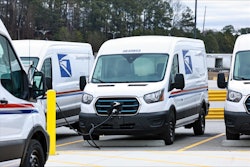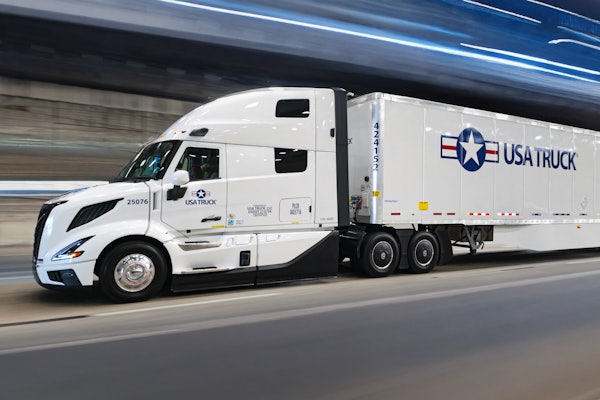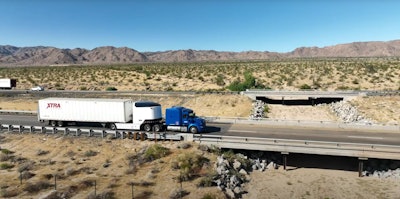
Revoy, a new EV unlike anything on the market, hopes to electrify trucking overnight, turning conventional in-use diesel tractors into hybrids achieving more than 30 mpg -- in just five minutes or so.
Here's how it works: Any diesel tractor can pair with the Revoy EV, which itself has an axle and a second fifth wheel. The trailer to be hauled simply hooks to the Revoy unit's fifth wheel, which uses some autonomous technology to reduce the legwork there. The three-part combo then hauls the load, with the Revoy unit providing most of the power to its own axle, and some residual diesel power running the cab electronics.
Revoy bills the EV as a service which is "purely additive," in that carriers don't pay anything up front.
"We offer a really different and much better and easier path for fleets to go electric," said Revoy founder Ian Rust. "We offer a service." Zero money up front for the unit, then: "customers pay us by the mile. It's really more of a fuel product. We charge them for the diesel we save them, altogether with the residual diesel, and our fees that are all inclusive."
The company establishes a baseline fuel mileage for any individual subscriber. "Typically fleets are keeping good track of their mpg, and then we're typically more than halving their diesel usage," said Rust, saving money on the whole.
The Revoy's electric unit has a range of about 250 miles, comparable to the Volvo VNR Electric and other EV offerings. On a 250-mile run, a truck getting 7 mpg might burn 35 gallons of diesel, which we'll say costs $4/gallon or $140. The Revoy EV would cut that in half, approximately, and bill the fleet for a cut of the difference.
Currently, Revoy operates two "swap stations" in Texas and Arkansas, and it has fleet customers whose drivers pull into the station where a Revoy attendant greets them and swaps out the spent battery. Rust said Revoy has stations planned in California and Oregon as well.
"We have four [Revoy EVs] built and three are in service on a commercial demonstration route hauling live loads," said Rust. "We contract with major fleets for these long-haul routes, and we prefer linehaul for consistent volumes in a consistent location."
Ultimately, these are pilot customers with a product that's in proof-of-concept mode as of yet. Revoy would obviously need to build out a network of swap stations to scale the business massively.
But, unlike other EV offerings, Revoy specifically targets long-haul.
"The way we enable long-haul is not that we have some magical battery chemistry, though we do use best in class batteries," said Rust. "The issue with range is more with charge, so now instead of a vehicle down for hours during a charge, we can swap the Revoy EV in four minutes."
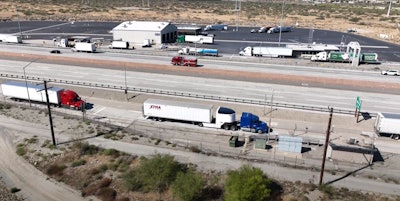
That's partly what makes the company's idea unique, and why it's a "modular" design rather than an attempt to integrate electric motors into diesel-burning trucks, another idea in prototyping stages now.
[Related: Meet 'Topsy', Edison Motors' new diesel-electric vocational prototype]
The Revoy units simply shuttle back and forth between swap stations, and the tractor continues on it's journey under diesel power as it normally would.
Rust said the "battery swapping model has a lot of challenges," not the least of which are lack of a common battery and swapping interface and the potential for heavy lifts needed at swapping stations. On the plus side, though, "hybrids can't run without the battery and just revert back to diesel" like Revoy can. "When permanently modifying the vehicle, that extra weight has range implications," as well as weight considerations with a heavy battery sitting on drive and steer axles.
Instead, the Revoy unit's fifth wheel is positioned to spread the weight out across a few axles.
What does the Revoy EV weigh? What are its dimensions?
And about that weight, does Revoy keep it a guarded secret like Tesla's Semi? No, Rust said. The Revoy EV unit weighs in at about 22,000 pounds, just 2,000 or so pounds lighter than a Volvo VNR Electric and as much as 6,000 pounds more than a Freightliner eCascadia.
[Related: Pepsi spills the beans on Tesla Semi's real-world hauling performance]
Additionally, because the Revoy isn't totally "zero emissions" out of the stacks, it doesn't get the extra 2,000 pound weight allowance that the VNR Electric or eCascadia would.
Rust admitted the 22,000 pound curb weight "isn't nothing," but insisted the payload impact for real-world customers was exactly zero.
"The key is when we encounter those trailers that can’t that afford the weight, we wave them on. We looked at the data," Rust said, adding that "two thirds of loads can accommodate the extra weight."
In high-value freight at least, the trend has been toward the extreme majority of loads cubing out before they ever weigh out.
The Revoy EV also adds 13 feet in length to the overall combination, and the company said drivers have found it "pleasantly maneuverable."
What do drivers think of the Revoy EV?
Beyond the concepts and prototypes, Rust prides himself on putting in real work in the trucking world to perfect the product.
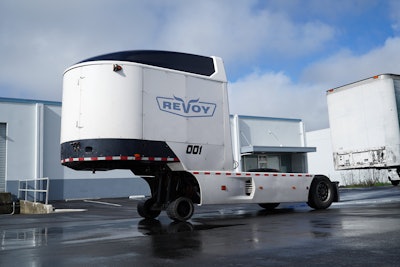 The Revoy unit pictured alone.
The Revoy unit pictured alone.
Benefiting from Rust's experience in robotics and autonomous vehicles, the Revoy does a lot of the fifth-wheel connections and yard moves by itself, completely unmanned.
"That's something drivers really love. They don’t have to go drive and reverse and go find the new trailer,' he said. "We do all that for them." Right now, that process includes an attendant, but Rust hopes to fully automate it.
Rust said one of his test drivers, a woman with 40 years behind the wheel, said she loves the EV's quick acceleration, and that the power coming from a separate, further back axle doesn't feel any different from the driver's seat. Other features like regenerative braking, and the additional brakes on the EV itself, promise to make the combination stop in shorter distances and reduce heat on the system.
Ultimately, Revoy hopes to build out a network of swapping stations and help anyone from mega fleets to owner-operators begin to decarbonize their hauls. What stands out about Rust's vision, at this point, is the road-tested aspect with real world hauls and miles, DOT inspections, "license plates and everything," he said.





